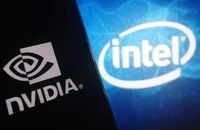Intel Corporation, once the undisputed leader in the semiconductor industry, found itself at the center of a Wall Street whirlwind this week, as the company’s stock price experienced its most dramatic swings in decades. The catalyst? A historic $5 billion investment from Nvidia, the reigning giant of artificial intelligence chips, and a bold 10% equity stake by the U.S. government—moves that have sent ripples through global markets, ignited fierce debate among analysts, and underscored the increasingly strategic role of chipmakers in the global economy.
On September 18, 2025, Intel shares soared nearly 28% in a single day, their largest one-day gain in almost forty years, according to Investopedia. The rally was driven by news that Nvidia would invest $5 billion to co-develop next-generation chips for data centers and personal computers, signaling a rare and powerful alliance between two titans of the industry. Nvidia’s CEO Jensen Huang hailed the partnership as a “historic collaboration that tightly couples NVIDIA’s AI and accelerated computing stack with Intel’s CPUs and the vast x86 ecosystem—a fusion of two world-class platforms. Together, we will expand our ecosystems and lay the foundation for the next era of computing.”
The market’s response was immediate and resounding. Intel’s stock hit a one-year high, while Nvidia’s shares rose more than 3%. The surge helped propel major U.S. indexes to all-time closing highs. The S&P 500, Nasdaq, and Dow Jones Industrial Average all advanced, with the Russell 2000 small-cap index notching its first record close since late 2021. As Investopedia reported, Intel was the top performing stock on the S&P 500 and Nasdaq that day, while Nvidia was a standout in the Dow.
Yet, as quickly as the euphoria set in, reality began to bite. By Friday, Intel shares had slipped 2.85%, pulling back from their highs as investors took profits and analysts voiced skepticism about the sustainability of the rally. The stock closed at $29.69, still up 57% year-to-date but now trading at valuations reminiscent of the dot-com bubble—about 57 times projected 12-month earnings, according to Parameter.io. Such lofty multiples raised eyebrows across Wall Street.
One of the most striking aspects of the recent events is the U.S. government’s deepening involvement in Intel. In August, the Department of Commerce agreed to purchase 433.3 million shares at $20.47 each, as part of the Chips Act initiative to bolster domestic semiconductor manufacturing. So far, Intel has issued 274.6 million shares to the government, with another 158.7 million in escrow, pending further disbursements. The total stake is now worth about $14 billion—a $4.9 billion gain in under a month. The White House has touted the move as a way to secure America’s chip supply chains and reduce reliance on overseas production, a sentiment echoed by Intel executives who say the partnership brings stability to their foundry operations.
But it’s not just government backing that’s fueling the excitement. Nvidia’s investment is widely seen as a vote of confidence in Intel’s turnaround efforts. For years, Intel has struggled to keep pace with rivals like AMD and TSMC, losing ground in both technology and market share. The new partnership aims to reverse that trend by co-developing chips that blend Nvidia’s AI and GPU expertise with Intel’s dominant x86 architecture and manufacturing prowess. As Nvidia CEO Jensen Huang put it, “Together, we will expand our ecosystems and lay the foundation for the next era of computing.”
Patrick Moorhead, CEO of Moor Insights, called the deal “huge for Intel, good for Nvidia,” noting that if executed well, it could give Windows AI PCs a credible scaling path and offer data-center buyers an x86 choice within Nvidia platforms. Retail sentiment echoed this optimism, with Intel becoming the top trending stock on Stocktwits and bullish chatter dominating online forums.
Still, not everyone is convinced. Wall Street analysts remain divided on Intel’s prospects. According to GuruFocus, the average one-year price target for Intel is $22.94, with high and low estimates ranging from $36.00 to $14.00—a downside of nearly 25% from current levels. The consensus from 47 brokerage firms is a “Hold,” with an average recommendation of 3.0 on a scale where 1 is “Strong Buy” and 5 is “Sell.” GuruFocus’s proprietary GF Value metric pegs Intel’s fair value at $23.36, suggesting the stock could be overvalued by more than 23%.
Analysts such as Ming-Chi Kuo of TF Securities see the Nvidia-Intel alliance as a potential game-changer for AI PCs and servers, especially for mid- and low-range enterprise deployments. Kuo highlighted the synergy between Nvidia’s CUDA platform and Intel’s vast distribution channels, predicting meaningful demand for x86-based inference AI servers. On the other hand, Gene Munster of Deepwater Asset Management warned that the market’s reaction was overblown: “As of this recording, shares of Intel are up 25%… I think that this is an overreaction. I don’t think they should be up 25%. I think they should be up more like five or 10% on this.” Munster attributed much of the surge to “meme stock” dynamics and the combined endorsement of the White House and Nvidia, rather than to fundamentals.
Market commentators like The Kobeissi Letter described the sequence of events as “unprecedented,” pointing out that Intel’s stock rose over 50% in just 27 days following the Trump administration’s announcement of its stake and Nvidia’s subsequent investment. The developments, they argued, highlight how chip companies have become pawns in the intensifying U.S.–China tech rivalry and how AI spending is now a dominant force in U.S. GDP growth.
Intel’s ties to Washington are not without strings. The company received $5.7 billion in cash from the government for its 10% stake, with the funding earmarked for its foundry division. Notably, the government secured a warrant to expand its ownership if Intel’s control over its foundry drops below 51%, though CFO David Zinsner has stressed that Intel intends to retain full control.
The broader semiconductor industry is also undergoing a strategic shift. Companies like AMD are willing to pay a premium to source chips from TSMC’s Arizona plant, prioritizing supply chain security even at higher costs. Intel’s arrangement with the U.S. government mirrors this trend, using public funds to offset the expense of domestic production and reinforce America’s technological independence.
For all the drama, the future remains uncertain. The partnership with Nvidia could indeed mark a turning point for Intel, but significant execution risks remain. The company’s current valuation leaves little room for error, and the competitive landscape—dominated by TSMC, AMD, and ARM—shows no signs of easing up. As Wall Street weighs optimism against skepticism, one thing is clear: the battle for chip supremacy has never been more consequential, or more closely watched.
In the end, whether Intel’s latest surge is the beginning of a true turnaround or just another chapter in the saga of market exuberance remains to be seen. For now, the world is watching—and so is Wall Street.





